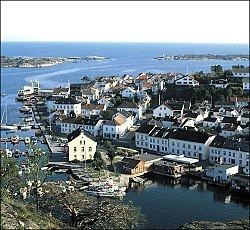District Sørlandet Area rank 332 in Norway Population 6,909 (2015) Official language form Norwegian Language | County Aust-Agder Administrative centre Risør Demonym(s) Risøring Local time Thursday 8:52 PM | |
 | ||
Weather 6°C, Wind SW at 10 km/h, 94% Humidity Area 193 km² (179.1 km² Land / 13.94 km² Water) Points of interest Risør Akvarium, HKB 35/379 Risør, Risørflekken, Risør Underwater Post Office | ||
Ris r norway in the winter
Risør is a city and municipality in Aust-Agder county, Norway. The city belongs to the traditional region of Sørlandet. It is a popular tourist place. The surrounding area includes many small lakes and hills, and is known for its beautiful coastline as well.
Contents
- Ris r norway in the winter
- Map of RisC3B8r Norway
- General information
- Name
- Coat of arms
- Politics
- History
- Geography
- Economy
- Attractions
- Notable residents
- References
Map of Ris%C3%B8r, Norway
Risør is famous for its tourist attractions such as the wooden boat festival which is staged during the first week of August every year. It also has a growing reputation as the regional capital of arts and crafts, which culminates in the "Villvin-festival" during the summer holiday.
General information
The city of Risør was established as a municipality on 1 January 1838 (see formannskapsdistrikt). On 1 January 1901, a part of neighboring Søndeled municipality (population: 658) was transferred to Risør. On 1 January 1964, the rural municipality of Søndeled (population: 3,134) was merged into Risør, giving the newly enlarged municipality with a population of 6,136. On 1 January 1984, the uninhabited Folevatnet area of neighboring Tvedestrand was transferred to Risør.
Name
The Old Norse form of the name must have been Ríseyjar. The first element is rís which means "thicket" and the last element is the plural form of ey which means "island". The name was originally referring to the island Risøya which is located just outside the town.
The old name of the town (until 1909) was Østerrisør (meaning "eastern Risør"). The first element was added in the 16th century to distinguish the town from Vesterrisør, the old name of Mandal.
Coat-of-arms
The coat-of-arms was granted on 18 July 1891. The arms show a lighthouse on a rocky island. This symbolizes the Holmen fortress built in 1788.
The history of these arms is quite curious. When on 18 July 1891 King Oscar II visited the city, a menu had to be printed. It was printed with a coat of arms on the top, which was probably designed by the printer. That afternoon the King approved the new arms, mainly because his name was printed under the arms on the menu.
Politics
In the 2007 municipal elections, Risør had the highest vote for the Red Electoral Alliance in Norway at 13.7 per cent. Also, Knut Henning Thygesen was elected as the only mayor from the Red Party through a direct mayor election.
History
Risør was a small fishing village when Dutch vessels began to call there to purchase timber in about 1570. By 1607 two inns had been opened to serve Dutch sailors. In 1630 Risør became a privileged port (ladestad).
The place is known for a church building from the Middle Ages, as well as a timber church Den Hellige Ånds (Holy Ghost) which was built in the Baroque style in 1647.
In 1723 Risør became a privileged town. By the end of the 18th century, 96 sailing vessels were owned by Risør merchants. It was the sixth largest shipping town and one of four shipbuilding centers in Norway.
In Letters on Sweden, Norway, and Denmark, Mary Wollstonecraft wrote extensively while visiting Risør in 1783, including the following remarks:
Risør played a role in the Napoleonic Wars in 1807-1814, when Denmark–Norway took France's side, and therefore became the enemy of Norway's most important trading-partner: Great Britain. (It is from this period that Henrik Ibsen took his subject, when he created his famous poem Terje Vigen.) It was south of Risør, in Lyngør (in neighboring Tvedestrand municipality) that several British warships, headed by HMS Dictator of the English navy pursued and sank the last major vessel and the pride of Norway: the frigate HDMS Najaden.
Risør was almost wiped off the map in 1861. A great fire swept across the small town leaving just 85 houses and the 1647 church. The city was rebuilt - and today it presents a positive impression of a well kept town with white wooden houses.
By the second half of the 19th century, over 100 sailing vessels were home ported in Risør and more than 1000 sailors called Risør home. But the transition to steamships and the economic damage of World War I destroyed Risør’s shipping industry.
Geography
Risør is the easternmost coastal municipality in Aust-Agder, located on the point where the Søndeledfjord and Sandnesfjord meet, providing ready access to the Skagerrak. (No connection with Sandnes in Rogaland.) It is bordered in the southwest by Tvedestrand, on the northwest by Vegårshei and Gjerstad in Aust-Agder and in the northeast by Kragerø in Telemark. The Nordfjorden is a branch of the Søndeledfjorden that is to the north of Barmen island heading towards the village of Søndeled.
Economy
Risør was a city built as a result of shipping and industrial interests. Today much of the industry and most larger sailing vessels are gone - leaving behind a picturesque town with a lot of summer tourist attractions.
The historic timber and fishing industries have mostly vanished. Paper production served as an economic basis for a period, until the pulp factory was closed in 1970. Currently tourism, a burgeoning art colony and summer vacationers account for a major part of the economy.
